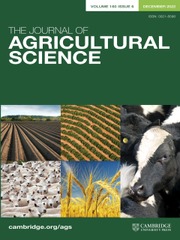Article contents
Sources of nitrogen and methods of application for flooded rice: I. Comparison of two methods of applying slow release and standard fertilizer materials*
Published online by Cambridge University Press: 27 March 2009
Extract
Field experiments with rice were conducted on a flooded soil comparing two standard fertilizers with N fertilizers with various release rates. For each of these fertilizer materials two methods of application were compared: broadcast and incorporated, and placement at 15 cm depth. The .slow release materials resulted in a lower grain yield than did fast or medium release rate or standard fertilizer materials. They released N too slowly during the early growth of rice to permit optimum plant growth and development.
Placement of 80 kg/ha N at 15 cm depth increased the plant N content at all stages of growth and significantly increased the grain yield compared with the broadcast-and-incorporated fertilizer treatment. The highest grain yield in the experiment (7701 kg/ha rough rice) was obtained from a medium release material, which was 88 % more efficient in increasing grain yield per unit of N when placed at 15 cm than when broadcast-and-incorporated.
The recovery of fertilizer N was 68% when deeply placed and 38 % when broadcast-andincorporated.
Information
- Type
- Research Article
- Information
- Copyright
- Copyright © Cambridge University Press 1967
References
- 3
- Cited by

